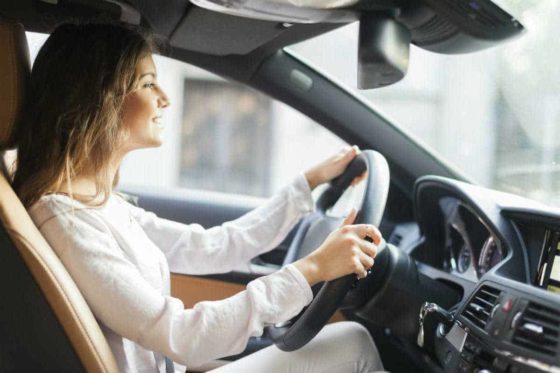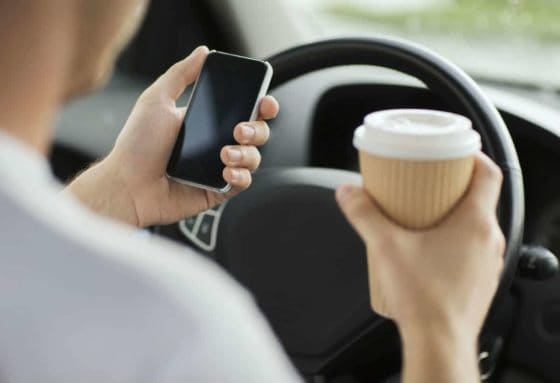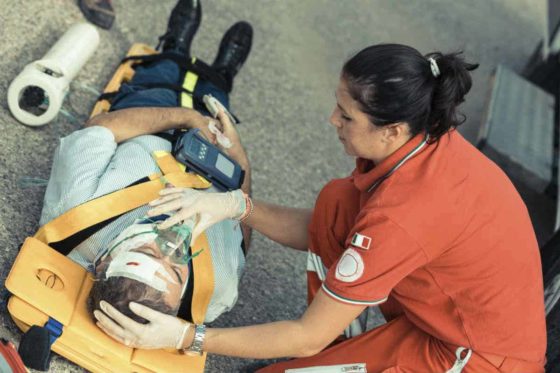Smart phone technology has surely contributed to an increase in distracted driving and automobile accidents.
Every piece of information, from anywhere in the world, is now available at our finger tips. If you want to chat with a friend thousands of miles away you can do it in a matter of seconds. However, this increased dependence on mobile technology has its own perils. We have come to a point where we cannot spend even a few minutes without texting, checking email, answering phone calls, or simply surfing the internet. It has become the number one distraction and is a leading cause of car accidents in Chicago.
What is Distracted Driving?

Distracted driving can include using a cellphone while driving, such as texting while driving, or talking while driving either by holding the cellphone in hand or by using a hands-free device. Distracted driving can also include using or manipulating a GPS device, eating food or drinking a beverage while driving, or even reaching down to grab something that has accidentally fallen onto the floor of the vehicle.
Any activity that takes a driver’s eyes off the road and distracts him or her from the task at hand is considered to be distracted driving. Distracted driving is unsafe driving and in some instances is illegal. For example, texting while driving has been illegal in Illinois since 2010, and yet many drivers still engage in this distracted driving behavior.
Facts About Distracted Driving
The Virginia Tech Transportation Institute’s 100-Car Naturalistic Study found that up to 80% of all crashes involve some type of driver distraction. The Illinois Tollway estimates that up to 24% of all traffic crashes in the United States each year are related to cell phone usage while driving, which correlates to 1.2 million accidents. In Illinois alone, in 2011, over 1,100 accidents involved cellphone usage while driving. The National Safety Council estimates that there is one cellphone-related distracted driver accident every 24 seconds.
Young people are the biggest offenders; specifically those age 20 and under. Using a handheld device increases the likelihood of having an accident fourfold, while texting and driving increases the likelihood of being involved in an accident 23 times during the period of time it takes to send a message.
Preventing Distracted Driving

Drivers should refrain from eating and drinking while driving, and should input GPS destinations before starting their trip. If the GPS destination needs to be corrected mid-trip, drivers should pull over to a safe stopping place to make any necessary adjustments to the GPS input.
The Danger of Distracted Driving
As mentioned earlier, distracted driving is responsible for over 20 percent of all car accidents. In 2013, over 3,000 people were killed on U.S. roads because of distracted driving. As more and more devices are making their way into our lives and vehicles, the epidemic of distracted driving is also growing. In spite of the strict laws in the state of Illinois against distracted driving, it still accounts for a large number of accidents that take place every year. It is important to understand the major distractions that can lead to an accident, so that you can avoid them.
Smart Phones and Chicago Auto Accidents

It’s hard to get a grip on just how many car accidents are really caused by cell phone use. Studies looking at the likelihood of cell phone use causing car accidents are not heartening. According to studies, drivers who are using a hand-held device are just as likely to get in an accident as drivers who are drunk. Drivers who are texting take their eyes off the road for long enough to travel an entire football field.
Worse, recent studies show that drivers do not realize the impact cell phones have on their driving. Only about 2% of people realize that cell phone use and texting cause them to drift out of their lane when driving, and the majority believe that cell phone use has no effect on their driving.
In response, Illinois has instituted bans on cell phone use for many drivers. School bus drivers cannot use cell phones at all. Drivers are not allowed to use hand-held cell phones in construction zones or near emergency response areas. Drivers under the age of 19 are not allowed to use cell phones in the car. And all drivers are banned from texting while driving.
However, some people still text and drive, especially in Chicago where busy professionals strive to be constantly in touch. If you have been hurt or lost a loved one in an accident with a texting driver or a driver using a cell phone, you may be able to receive compensation for your injury or loss.
Common Distractions While Driving

- Using electronic devices such as smartphones or tablets. Texting, answering phone calls, and checking emails are tasks that take your mind off the road.
- Drinking and eating.
- Grooming or applying makeup.
- Checking and concentrating on a GPS.
- Changing music or adjusting the settings on the dashboard.
- Talking to passengers.
- Looking outside at an accident or construction site.
To combat distracted driving, Illinois is the first Midwestern state to have passed the legislation to outlaw the use of phones without a hands free device. The penalty for the first offense is $75 and for subsequent violations it is $100, $125 and $150.
Handheld Cell Phones Now Illegal When Driving in Illinois
As of January 1, 2014, Illinois joins 11 other states plus Washington, D.C. in prohibiting the use of handheld cell phones while driving.
Drivers are no longer permitted to hold a handheld to their ear to talk, except in case of emergencies. Motorist are still permitted to use headsets, speakerphone or voice-activated dialing while driving. Texting is already illegal under Illinois law.
Why the ban?
Although scientific studies yield varying results, using a handheld cellphone while driving is largely considered distracting for the driver and may increase the risk of an accident. One study indicates that talking a cellphone reduces a drivers’ reaction time to levels observed in drunk drivers or senior drivers, while another suggests that talking on a cell has no impact on crash rates at all.
One thing that is clear, however, is that distracted driving is generally connected to thousands of car accidents and deaths each year. The National Highway Traffic Safety Administration reports that 3,328 people died in distraction-related crashes in 2012, and about 387,000 were injured.
Governor Pat Quinn, in signing the bill into law, said in a prepared statement: “Too many Illinois families have suffered because of accidents that could have been prevented. Anyone driving a car should be careful, responsive and alert behind the wheel. These new laws will save lives.
What’s the fine?
Violations of the law will lead to fines ranging from $75 for first time offenders to $150 for repeat offenders. Repeat offenders may also get a moving violation on their driving record. If you receive three moving violations within a year, your drivers license could be suspended. In addition, the new law dictates that if you cause a fatal accident while using a handheld device, you could be imprisoned for up to three years and fined as much as$25,000.
Current Prohibitions in Chicago, Illinois
- Drivers are prohibited from texting and related activities such as internet use.
- Drivers are prohibited from using handheld electronic communication devices.
- Drivers are prohibited from the use of cell phones on construction and road maintenance zones and school speed zones.
- Drivers under the age of 18 are prohibited from the use of wireless phones with or without a hands free device.
- Taking photos or videos on wireless devices is prohibited within 500 feet from an emergency scene.
Cell Phone Use While Driving Claims Lives

As Dangerous as Drunk Driving
Many studies have shown that activities associated with cell phone use can make a driver as dangerous as a drunk driver. It is important for drivers to realize that their actions contribute to the safety of everyone they share the roads with; it is important to put safety first. Drivers must avoid texting while driving, sending or receiving emails, accessing social media networks, streaming content or watching videos, or any other activity that can take their attention away from the main task at hand. Parents of young drivers should educate their children about the dangers of cell phone use while driving and be a good role model to them. Everyone must encourage family and friends to avoid using cell phones while driving and use reasonable care to prevent accidents from occurring.
Tips for Preventing Teens From Texting and Driving

The alarming rate of accidents caused by texting and driving should compel us to think about ways to prevent teens from texting while driving. Good communication between parents and their teenage drivers can go a long way in preventing this habit from developing. From the moment their child is learning to drive parents should make it very clear that texting while driving is never acceptable and help their teen to understand the consequences of doing so. It is also important for parents to set a good example by avoiding all forms of distraction while behind the wheel.
Help your teen understand that texting while driving is not just risky, it is also against the law.
Explain to them why texting while driving is dangerous
Even though most teens know that texting while driving can lead to accidents they often don’t understand how. They may think that looking at their cell phone for a few seconds won’t do any harm. This is far from true. Even a few seconds of distraction can lead to a serious accident. Explain to your teen that texting and driving distract you in more than one way. It takes your mind off the task, it takes your hands off the wheel, and eyes off the road. Doing this even for a couple of seconds is a recipe for disaster.
Research has shown that sending or receiving a text message takes the driver’s eyes off the road for about 4.6 seconds, and this is equivalent to the time it takes to travel the full length of a football field. So, you can imagine the risk that you take just by receiving or sending a text message while driving.
Distracted Driving Is Not Just Texting

Preventing Texting and Distracted Driving Car Accidents
When you’re texting, you take your eyes off the road for a significant length of time. Five seconds at 55 mph, your car will travel the length of a football field in that time. At 35 mph, you will travel almost the length of a typical city block in Chicago. Even going only 20 mph you will travel almost 150 feet, more than 10 car lengths. That’s a long distance to travel in your neighborhood, where kids and pets may be running into the street and people pulling out of obstructed driveways.
New federal guidelines seek to change the way smartphones can be used while driving.
Preventing Distracted Driving Fatalities

In response to these guidelines, the Consumer Technology Commission, which includes members such as Samsung and Apple, has said that the guidelines are too extreme and would prevent the use of features that can help drivers make better decisions.
How Serious is the Problem?
Last year, the total number of highway deaths in the U.S. reached 35,092, a 7.2 percent increase over the past year. This increase can partly be attributed to an increase in the number of people driving and partly to other causes such as drink driving, speeding, and distractions. The number of distracted driving deaths accounted for 10 percent of all traffic-related deaths, an 8.8 percent increase over the previous year. Considering the trends, traffic experts expect these numbers to further increase in the current year as well.
Curbing the Epidemic
While federal agencies are taking steps to prevent the use of devices that can cause distraction while driving, it is ultimately the responsibility of all drivers to prioritize safety. Simple things that drivers can do include:
- Send texts, finish conversations, and set GPS direction before putting the vehicle into drive.
- Put the phone on silent mode or keep the phone in an area out of reach so that you do not instinctively use it the moment you hear a beep.
- If there is an urgent call that you must answer, carefully pull off the road or exit the highway. Do not merge into traffic before you finish your business.
- If you have a passenger, you can request them to take calls, manage the GPS, or reply to messages on your behalf.
Avoid Texting and Driving Accidents as a Driver
The best way to avoid texting and driving accidents is to just not text and drive. Not ever. If you have trouble resisting the temptation, put your phone out of reach. Put it in a bag, your glove compartment, or the backseat. Turn it off while you’re driving. If you absolutely have to stay in contact, pull over and do your texting. If you have a passenger, hand it over to them.
Avoid Texting and Driving Accidents as a Passenger
Passengers can also help avoid texting and driving accidents. When you’re in another person’s car, etiquette typically demands respect and deference, but this is an occasion where you may have to be brusque. If the driver is starting to text, first offer to help them. If you can’t help, remind them that texting and driving is illegal in Illinois. Ask them to pull over. If reasonable, you might also offer to drive.
Deaths by Distracted Driving Are Under-reported
According to the US National Highway Traffic Safety Administration, some 80% of accidents are caused by distracted driving, and one of the most distracting activities drivers engage in is talking or texting on a cell phone.
Despite these astonishing numbers, up to half of the fatalities caused by distracted driving are not reported as such.
The NHTSA fears that if police are not trained to pursue and report the possibility of distracted driving being a factor in fatality crashes, it will be much more difficult to pass legislation to prevent drivers from using their cell phones on the road.
Why Report?
Public behavior only changes when people are made aware of the seriousness of the issue. There are a number of ways to do so: traffic laws may change, for example, as they were in the case of seat belt usage, or a public awareness campaign may be conducted to convince people to change their behavior for their own wellbeing.
However, it is difficult to convince state or federal legislators to make such laws if they see no real reason to do so, and it is extremely hard to get funding for public awareness campaigns if distracted driving is not seen as a serious issue.
If the number of fatalities were accurately reported, it would be much easier to convince legislators and the public that distracted driving is a serious issue that merits attention and action.
Where Current Reporting Falls Short
Different states have different standards for investigating whether distracted driving was a factor in an accident.
Tennessee reports the highest percentage of its driving-related fatalities, but California reported only a handful, despite having a population over six times that of Tennessee and far more urban areas where traffic accidents are common and cell phone usage is prevalent.
In states where police are not trained to investigate the possibility of cell phone use during an accident, distracted driving is generally only reported as a cause if the driver, a passenger, or a witness tells the police a cell phone was being used.
For obvious reasons, in fatal accidents these reports are rarely made: the driver and passenger are often unable to report any such thing, and it is not common for witnesses to a fatal accident to be close enough to see the driver using a cell phone.
The Legal Complication
Even in instances where police may suspect that cell phone use was a factor in the accident (if the investigating officer sees a cell phone on the floor of the driver’s seat, for example), the current laws make it very difficult for them to confirm their hunch.
In most cases, police are required to get a subpoena to see the driver’s cell phone records, which is an enormous hassle to go through, especially when discovering that cell phone use was a factor rarely changes anything for the victims of the accident.
Police must also prove that the driver was using their cell phone at the precise moment of the crash, which is difficult to do: the precise time of the crash is not always known, and if the driver was merely looking at their phone while driving, there is no record of that usage and no way of proving it.
Protecting Yourself
It’s simply not worth the risk of using your cell phone – even for a moment – while driving. The distraction of a cell phone is far greater than you likely realize, and it makes you much more likely to be in an accident.
If you need to use the cell phone right away, pull over to the side of the road; if you’re merely curious, wait until you arrive at your destination.
If you’re ever in an accident and you suspect the other driver was using their cell phone at the time, be sure to report your suspicion to the police. If you’re having trouble convincing the police officer of the other driver’s being at fault because of distracted driving, give us a call: we can help.
Distracted Driving Common Among Dog Owners

Distracted Driving While Traveling with a Pet
Pet owners often engage in different types of distractions when their dogs ride with them in the car. Research shows that 17 percent of dog owners admit to allowing their pets to ride on their lap when driving. Additionally, 52 percent of pet owners who ride with their pets in the car pet their dogs while driving. Another 13 percent feed their pets while driving. 4 percent of dog owners driving with their pets in the car admitted to playing with them while driving.
When a pet owner engages in any of the above-mentioned behaviors, the focus and eyes are taken off the road. Distracted driving is an extremely dangerous practice; taking your eyes off the road even for two seconds significantly increases the risk of a crash.
The Risk of Driving with a Pet
According to the survey, around 60 percent of the dog owners take their pet for a ride at least once every month. Most of these drivers interact with their pet while driving. Many of the drivers keep their dog in the front seat or even on their laps while driving. Those who keep their dogs in the back seat often turn around and try to reach their pets in the back seat, while others may bend over and try to touch their pet with a hand or arm in an attempt to keep the dog from coming to the front seat.
Safely Driving with a Pet
If a dog owner gets into a car accident with a pet in the car, the pet is in danger and could also injure others in the car. Only 16 percent of dog owners use a restraint system to secure the dog while traveling. A dog that is not restrained can become a projectile, causing severe injuries. The force of impact with an animal can cause severe and life-threatening injuries.
To prevent such injuries, it is extremely important that the dog does not become a distraction. An important step to safety is using a proper pet restraint system, which can prevent the dog from becoming a projectile in the event of a crash. There are various types of restraint systems available such as pet seat belts and crates that can be securely fastened in the vehicle. These restraints can keep the animal and passengers safe.
Driving with an Unrestrained Pet
More than 80 percent of the drivers know that it is safe to use seat belts or pet restraints while driving with a pet, yet only 16 percent of the pet owners who bring their pets in the car said that they use these safety features while driving. When a driver chooses not to use pet restraints, he or she is more likely to be involved in an accident. Furthermore, if an accident occurs while driving with a pet unrestrained in the vehicle, the driver and other occupants are likely to suffer severe injuries. Driving with a dog is not illegal, but drivers do need to understand that it is their responsibility to take all possible precautions to avoid or at least reduce any risk of accidents.
Is Social Media Contributing to Car Accidents?

- Encourages interaction between passengers and driver: posing for a selfie while driving causes a lot of distraction.
- Visual distraction: Whether a driver is taking a selfie, posing for one, or uploading it to a social media account, it requires him or her to take their eyes off the road.
- Taking and posting a selfie requires more time compared to texting: Texting and driving has been shown to be a reason behind a large number of car accidents each year. When we compare texting to taking and uploading selfies, selfies take much more time, which means the driver is distracted for a longer period of time.
- Encourages risk-taking behavior: According to safety experts and psychologists, some people take selfies to impress others. This means it is possible for drivers to take more risks than they usually do. They may drive recklessly or take selfies in a dangerous driving or traffic situation to take a more exciting photo.
- Peak social media activity time coincides with rush hours: Peak times for uploading photos to social media sites are 8PM on weekdays and 5PM on Sundays. Evening and weekend driving has its own risks and when we add the risk of taking and uploading selfies to it, the risk of an accident increases even further.
- Requires a driver to take hands off the steering wheel: When a driver takes a selfie or uploads it to social media, he or she has to take both hands off the steering wheel, multiplying the chances of a crash.
Social Media Is a Distraction
Drivers have become reasonably aware about the risks of texting and driving; however, there is little awareness about the risks of taking selfies and uploading them and no stigma is attached to it. Drivers openly take and flaunt selfies on social media. People have gone to the extent of taking selfies on the hospital bed after having been in a car crash. There is a call for more responsibility on the part of drivers to prevent crashes caused by selfies and other types of distraction.
Chicago Car Accident Lawyer
If you or someone close to you has been injured in an accident caused by a distracted driver, speak with an experienced Chicago car accident lawyer from Willens & Baez about your case.












